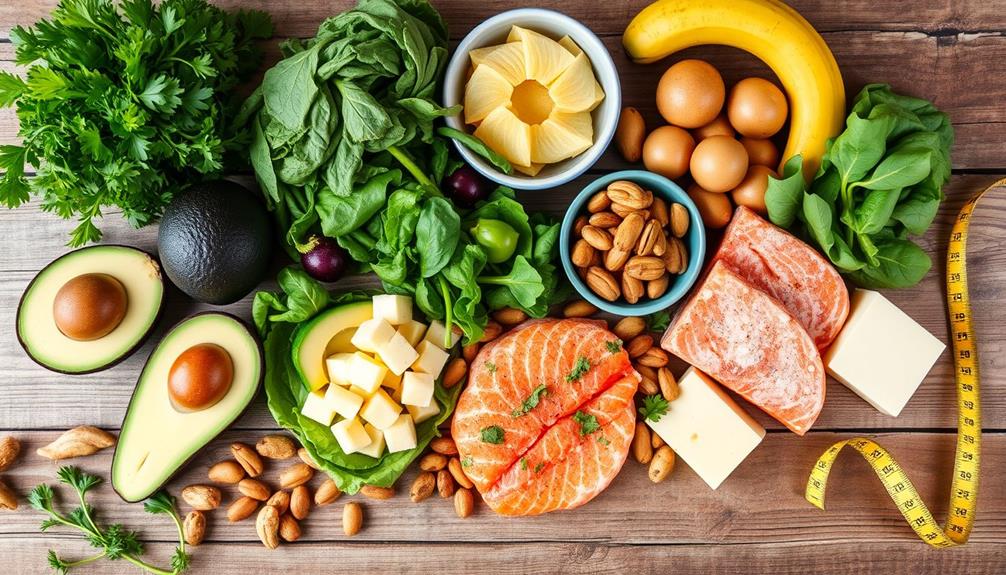To calculate a ketogenic diet, start by determining your personal data like age, weight, and activity level to find your Basal Metabolic Rate (BMR) and Total Daily Energy Expenditure (TDEE). Then, set your macronutrient ratios, aiming for 70-80% fats, 5-10% carbs, and 10-20% protein. Limit carbs to under 50 grams daily, ideally around 20 grams, to maintain ketosis. Use keto apps to track your intake and adjust as needed. Stay mindful of hydration and meal prep to stay on track. There's plenty more to uncover about optimizing your keto journey as you go forward.
Key Takeaways
- Calculate your Basal Metabolic Rate (BMR) using the Mifflin-St Jeor equation based on your age, gender, height, and weight.
- Assess your Total Daily Energy Expenditure (TDEE) by factoring in your activity level to determine your caloric needs.
- Establish a macronutrient ratio of 70-80% fats, 5-10% carbohydrates, and 10-20% protein for your daily intake.
- Limit carbohydrate intake to 20-50 grams of net carbs daily to maintain ketosis and promote fat utilization for energy.
- Monitor your ketone levels regularly to ensure they stay within the ideal range of 1.5 to 3 mmol/L for effective ketosis.
Understanding the Ketogenic Diet

When you immerse yourself in the ketogenic diet, you'll notice it fundamentally alters how your body fuels itself. The primary goal of keto is to shift your metabolism from burning carbohydrates to fats, achieving a state known as ketosis. To get there, you'll typically limit your carbohydrate intake to less than 50 grams daily.
This low-carb approach allows your body to produce ketone bodies from stored fat, providing an alternative energy source for your brain. Additionally, maintaining proper hydration is important, especially as a ketogenic diet may lead to increased water loss and electrolyte imbalances monitor hydration levels.
The standard macronutrient ratio for a ketogenic diet is approximately 70-80% fats, 5-10% carbohydrates, and 10-20% protein. This differs considerably from other low-carb diets, focusing on high fat intake while meeting your protein needs.
Adopting this ratio can help you create a caloric deficit, which is essential for weight loss. Furthermore, the ketogenic diet has shown promise in improving insulin resistance, a common metabolic issue.
Historically, it was used for medical treatments like diabetes control and epilepsy management. By embracing the keto lifestyle, you might experience considerable weight loss and metabolic benefits in the short term, making it a compelling option for many.
Key Components of Keto Calculation

To calculate your ketogenic diet effectively, you'll need to input personal data like your age, weight, and activity level. With this information, you can determine the number of calories and macronutrients you need to consume each day in order to maintain ketosis. It’s important to understand the keto diet basics, such as avoiding high-carb foods and focusing on consuming healthy fats, moderate protein, and low-carb vegetables. By tracking your food intake and making adjustments as needed, you can successfully follow a ketogenic diet and experience its potential health benefits.
Understanding the importance of balancing macronutrients is vital to achieving your dietary goals.
Next, you'll determine the right macronutrient ratio that fits your goals, focusing on the balance of fats, proteins, and carbohydrates.
Personal Data Input
Calculating your ketogenic diet needs starts with some fundamental personal data input that greatly impacts your results.
You'll need to gather key factors like your age, gender, height, weight, and body fat percentage. These components are critical for determining your Basal Metabolic Rate (BMR) and Total Daily Energy Expenditure (TDEE), which directly influence your caloric needs.
Understanding your overall health and any specific dietary considerations, such as financial considerations for elderly care, can also aid in making informed decisions about your diet.
Your activity level also plays a significant role in these calculations. Whether you're sedentary or very active, your daily movement affects how many calories you burn, so make sure to reflect on this when inputting your data.
Gender and age are essential for accurate calorie calculations, as they influence your metabolic rates and nutritional needs for effective weight management.
Furthermore, including your body fat percentage helps assess your lean body mass, which is important for determining appropriate protein requirements on a ketogenic diet.
Macronutrient Ratio Determination
Understanding your macronutrient ratios is vital for effective ketogenic diet planning. The typical macronutrient ratio for a ketogenic diet consists of 70-80% fat, 5-10% carbohydrates, and 10-20% protein. This ratio helps promote ketosis by markedly lowering your carb limit. To achieve ketosis, aim for a net carbohydrate intake of less than 50 grams per day, ideally targeting around 20 grams.
Maintaining a balanced diet with proper macronutrient ratios is essential for overall health and can complement other dietary strategies, such as avoiding high-purine items that may affect your body's metabolism.
Your protein intake should align with your activity level. Sedentary individuals generally require about 0.6g-0.8g of protein per pound of lean body mass, while active individuals need 0.8g-1.2g.
After determining your total daily calories, subtract the calories from protein and carbohydrates to figure out how many grams of fat you need. Since there are 9 calories per gram of fat, divide the remaining calories by 9 to get your fat intake.
Maintaining the right macronutrient ratio is essential. Excessive protein can hinder ketone production, and proper carb restriction is necessary for entering and sustaining ketosis.
Caloric Needs Calculation
Establishing your caloric needs is the next critical step in implementing a ketogenic diet. Start by determining your Basal Metabolic Rate (BMR) using the Mifflin-St Jeor equation, which considers your age, gender, height, and weight.
Understanding your financial health can also help you allocate resources for your dietary changes. Once you have your BMR, assess your activity level to calculate your Total Daily Energy Expenditure (TDEE). Multiply your BMR by an appropriate Physical Activity Level (PAL) factor to find the calories you burn in a day.
If you're aiming for weight loss, you'll want to create a calorie deficit of 20-30% from your TDEE. For maintenance, consume your TDEE in calories.
The standard ketogenic diet typically consists of 70-80% fat, 5-10% carbs, and 10-20% protein. You'll need to set your macronutrient goals based on your total daily caloric intake.
Convert your desired percentages into grams by dividing the calorie allotments for each macronutrient: fat has 9 calories per gram, while protein and carbs have 4 calories per gram.
Inputting Personal Data

When starting on your ketogenic diet journey, inputting accurate personal data is essential for best results. This data includes your gender, age, height, weight, and activity level. Using a keto calculator, you can apply the Mifflin-St Jeor equation to determine your Basal Metabolic Rate (BMR), which helps assess your caloric needs. Additionally, your body fat percentage is needed to evaluate your lean body mass and tailor your protein requirements.
To get precise recommendations, make certain your activity level is categorized correctly. Here's a quick reference table to help you understand the activity levels:
| Activity Level | Description | Example |
|---|---|---|
| Sedentary | Little to no exercise | Desk job |
| Lightly Active | Light exercise or sports 1-3 days/week | Walking, yoga |
| Moderately Active | Moderate exercise 3-5 days/week | Running, cycling |
Accurate personal data influences your Total Daily Energy Expenditure (TDEE) and macronutrient distribution, guaranteeing you achieve effective results on your ketogenic diet.
Determining Macronutrient Ratios

To effectively follow a ketogenic diet, you need to determine the right macronutrient ratios tailored to your individual goals. The typical macronutrient ratio for this diet is around 70-80% fat, 5-10% carbohydrates, and 10-20% protein.
Additionally, incorporating certain essential oils, such as peppermint oil for invigorating energy, may complement your dietary efforts. To reach ketosis, your daily carbohydrate intake should generally be limited to 20-50 grams of net carbs, which you calculate by subtracting fiber from total carbohydrates.
Your protein intake will vary based on your activity level. Sedentary individuals typically need about 0.6-0.8 grams of protein per pound of lean body mass, while those who are more active may require 1.0-1.2 grams.
For example, on a 2,000 calorie ketogenic diet, you might aim for approximately 25 grams of carbohydrates, 156-178 grams of fat, and 100-150 grams of protein, depending on your specific goals.
Accurately calculating these macronutrient ratios is essential for effective adherence to the ketogenic diet. By focusing on your total calorie intake and balancing grams of fat and protein accordingly, you'll be on the right track to achieve your desired health outcomes.
Monitoring and Adjusting Intake
Monitoring your intake is essential for staying on track with the ketogenic diet and ensuring you reach your health goals. To effectively manage your macronutrient intake, aim for a typical ratio of 70-80% fat, 5-10% carbohydrates, and 10-20% protein. Use a keto calculator or apps like Cronometer or MyFitnessPal for food tracking, making it easier to log your carbohydrate intake and adjust accordingly.
Here's a simple guide to help you monitor your intake:
| Macronutrient | Recommended Ratio |
|---|---|
| Fat | 70-80% |
| Carbohydrates | 5-10% |
| Protein | 10-20% |
| Total Carbohydrates | < 50 grams daily |
Regularly test your ketone levels using keto sticks or blood meters, aiming for 1.5 to 3 mmol/L for effective ketosis. If you notice weight loss stalling or experience keto flu symptoms, it may be time to adjust your caloric needs and macronutrient distribution. Remember, excessive protein intake can hinder ketone production, so keep an eye on your protein intake relative to your activity levels.
Common Challenges and Solutions

When starting a ketogenic diet, managing cravings can be tough, but with the right strategies, you can stay on track.
Incorporating various brewing methods can help you enjoy your coffee while maintaining your keto lifestyle, as black coffee is typically low in calories and carbs.
Meal preparation is key to ensuring you have keto-friendly options readily available, and staying hydrated helps curb those pesky hunger pangs.
Let's explore some practical tips to tackle these challenges head-on.
Managing Cravings Effectively
Managing cravings effectively on a ketogenic diet is vital for your success and overall well-being. Cravings often arise from the initial reduction of carbs, which can lead to symptoms like fatigue and irritability, commonly known as "keto flu." Understanding the psychological aspects of cravings, such as emotional dysregulation, can provide valuable insights into managing these urges emotional dysregulation. Staying hydrated and maintaining your electrolyte balance can help alleviate these symptoms.
Incorporating high-fat snacks, such as nuts, cheese, or avocado, is a great way to satisfy hunger and curb cravings while adhering to your keto macro ratios.
Meal planning is important; by preparing your meals and snacks in advance, you can prevent impulsive eating and reduce temptation.
Regular physical activity can also help distract you from cravings and boost your mood, as exercise releases endorphins that diminish the desire for high-carb foods.
Additionally, utilizing mindfulness techniques like meditation or deep breathing can support emotional regulation and reduce the frequency and intensity of cravings triggered by stress or boredom.
Meal Preparation Tips
Meal preparation is the backbone of a successful ketogenic diet, helping you stay on track with your macronutrient goals. To navigate common challenges, consider these tips:
| Challenge | Solution | Key Tools |
|---|---|---|
| Sticking to carb limit | Batch cooking low-carb meals | Meal planner |
| Boredom with meals | Use a variety of keto-friendly recipes | Recipe catalog |
| Overeating | Track macros and portion sizes | Macro tracking app |
By keeping a well-stocked pantry with keto-friendly staples like healthy fats, low-carb vegetables, and protein sources, you'll streamline your meal prep. This will help you avoid impulsive eating, ensuring you meet your caloric goals. Utilizing a meal planner can provide structure and reduce the likelihood of deviating from your macronutrient ratios, which typically consist of 70-80% fat, 5-10% carbohydrates, and 10-20% protein.
Don't forget to track your food intake. Using apps can help you log meals effectively, making it easier to align your meals with your individual caloric and macronutrient goals. Meal preparation is key to your ketogenic diet success!
Staying Hydrated Regularly
Staying hydrated is essential on a ketogenic diet, as your body tends to lose more water and electrolytes during this change. If you don't maintain proper hydration, you might experience symptoms of dehydration, especially during the initial stages when the "keto flu" may kick in.
Additionally, keeping your environment clean and free from allergens can help support your overall health during this alteration, much like how proper air purification can enhance indoor air quality for better breathing air purifier maintenance dos and don'ts.
To keep your hydration levels in check, consider these strategies:
- Increase your water intake: Aim for at least 2 to 3 liters daily to support your body's needs.
- Incorporate electrolyte-rich foods: Foods high in sodium, potassium, and magnesium can help balance your electrolytes and reduce dehydration risks.
- Monitor your urine color: A pale yellow color indicates adequate hydration, while dark yellow suggests you need more fluids.
- Try herbal teas or lemon water: These options enhance hydration without adding significant carbs, making your water intake more enjoyable.
Frequently Asked Questions
How Do I Calculate My Keto Carb Limit?
To calculate your keto carb limit, aim for 5% of your daily calories from carbs. Generally, that's about 20 to 50 grams. Test your ketone levels regularly to find your personal threshold.
How Do You Measure Your Keto Level?
To measure your keto level, use urine test strips, blood meters, or breath analyzers. Testing in the morning provides accurate results, while staying hydrated prevents dilution of urine and guarantees reliable readings.
How Many Carbs Should I Eat a Day on a Keto Calculator?
You should aim for 20-50 grams of net carbs daily on a ketogenic diet. Using a keto calculator tailored to your personal metrics can help you determine the exact carb intake needed for your goals.
What Is the 80 20 Rule for Keto Diet?
The 80/20 rule for the keto diet means you should aim for 80% of your calories from fats and 20% from protein and carbs. It offers flexibility while keeping you in ketosis. Enjoy your meals!
Conclusion
By understanding how to calculate your ketogenic diet, you can tailor it to fit your lifestyle like a perfectly crafted suit. Remember, it's all about finding the right balance of macronutrients that fuels your body while keeping you in ketosis. As you monitor and adjust your intake, you'll navigate the challenges with ease, turning obstacles into stepping stones. Embrace the journey, and soon you'll be reaping the rewards of your hard work and dedication.








